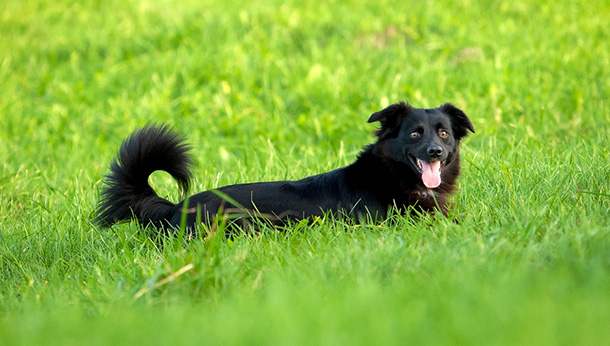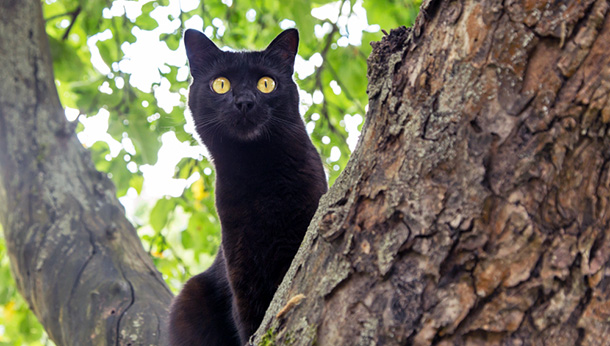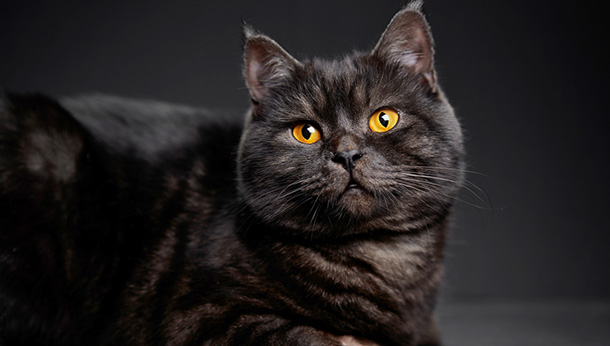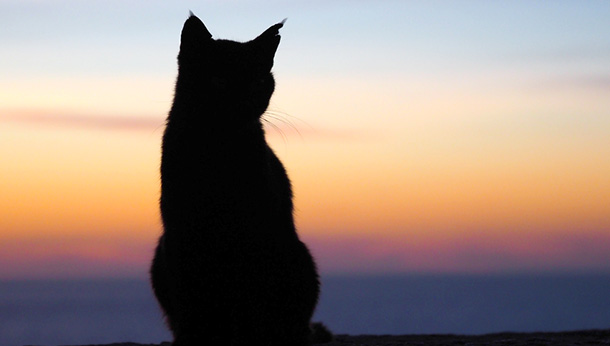TAKING GREAT, INSTAGRAM-WORTHY PHOTOS OF BLACK PETS HAS THE BANE OF PET PARENTS SINCE FOREVER
PICTURE THIS: You’re out playing with your cherished black-furred dog on the beach having the time of your life. Wouldn’t the cherry on top be a professional-grade snapshot to document the event for all of time, not to mention the satisfaction of seeing a subsequent flood of ♥’s on Instagram?
The problem, no matter how hard you try, is that the photos emerge as a black splotch rather than a representation of the beautiful animal they are. Pets with black coats are particularly difficult to photograph due to their stunningly dark-coloured fur, making it hard to capture their striking features.
Worse still, black dogs and cats tend to stay in rescue shelters or the local Humane Society/SPCA much longer than their light-coloured colleagues. Unfortunately, some never get that lucky break of being re-homed based just on the colour of their fur.
There are possibly two explanations at work here. First, because black pets are notoriously difficult to photograph – especially in the age of posting our best lives on social media – they tend to get overlooked at shelters or in a litter. Secondly, a long-standing, absurd belief still exists that black cats are harbingers of bad luck.
So, what’s the secret to getting excellent photos of your black companion animal?

Whether you’re a pet parent – or work in a rescue shelter – here are 4 useful tips when photographing black pets. Don’t worry, you won’t need any fancy photography equipment or software (ie. high-end, DLSR cameras, Adobe Lightroom), although it would be helpful. We’ll assume that you’re using your smartphone with automatic settings.
FOUR EASY TACTICS TO HELP TAKE GREAT, INSTAGRAM-WORTHY PHOTOS OF YOUR BLACK PET
1. LIGHTING: SOURCE AND POSITION
What is the biggest challenge of black pet photography?
LIGHTING!
Lighting in photography refers to how the light source – and its position – relates to the main subject (your pet) of the photograph. It determines brightness and darkness in addition to tone and mood. Paying close attention to how light affects the quality of your pictures will empower you to employ the available light source to produce excellent Instagram-worthy pictures of your furry friend.
Getting the lighting right is usually what frustrates budding pet photographers the most. Sometimes the lighting for the photo location could be near perfect but your pet is too dark (underexposed), or the lighting could be good but the background looks washed out (overexposed).
4 Lighting Tips when Taking Photographs of Black Pets Outdoors:
- Avoid hard light conditions, such as bright, overhead sunlight – take you dog to an evenly shaded area to reduce contrast. Too much contrast can give your pet a bright glare on some parts of their dark coat and solid black shadows on others.
- Auto-modes underexposing your photos? Take a crash course on your smartphones’ cameras manual settings – you may be surprised by the amount of control a hi-tech smartphone camera can give you.
- Take memorable photos during the “Golden Hour”, typically 1 hour after sunrise and 1 hour before sunset for the best natural light.
- If it’s a little too dark (heavy clouds) or there’s too much backlight to bring out your dog’s features, try supplementing your available light with fill-in flash to compensate for the differences.
Direct Sunlight
Contrary to what you might expect, bright direct sunlight isn’t great for photographing black pets. Very bright light means your camera works too hard resulting in a battle between two extremes – the black coat of your pet against the white light of the sun. If you do find yourself with the sun directly overhead, bring your dog (or cat) to a shaded area to take the photo. It’s important that your chosen location is evenly shaded. For example, if you take the photo under a shade tree, make sure that the background isn’t too brightly lit.
The important part of showing off the details of a black pet is getting a balance between shadow and highlight, and not letting the pet be too dark in the photo.
Auto-Modes
It is really easy to underexpose your image when shooting pictures in auto-mode. Although auto-modes continue to get ‘smarter’, your smartphone camera will look at the scene to figure out the right settings and think that your pet isn’t much more than a dark shadow. This means your photo may be too dark, with too little detail for your pet stand out or ‘pop’. This is where capturing shots using manual settings can be very helpful, provided you’re prepared to put in the time to learn and experiment. Most smartphone have these features built-in (or download a free, 3rd party app) which will provide seemingly endless options to manually adjust your camera for that perfect shot.
The Golden Hour
When taking photographs of black pets in direct sunlight, there are two ideal times of day to do this: on sunny days, this is shortly after sunrise or just before sunset. Generally speaking, the “golden hour” is roughly 1 hour after sunrise or 1 hour before sunset.
Camera Flash
If it’s a little too dark or there’s too much backlight to bring out your pet’s features, try supplementing the available light with fill-in flash. Working with flash is most effective when conditions are not too dark or too bright. When the dog is in shade, a splash of flash can help them to be seen better, raise the light in the shadow and get the eyes to be seen more clearly. Experimentation is important, but used properly, fill-in flash helps lighten the dark areas to reveal more subtle features of your black-furred pet.
2. BACKGROUND: COLOURS, TEXTURES AND BOKEH
def. Bokeh: In photography, it’s the intentional blurring of an image (ie. background) to make the subject more visually appealing. It forces the focus of attention to a particular area of the image. The word comes from the Japanese language, which literally translates as “blur”.
In photography, backgrounds play a huge role – it can literally make or break a photo. For photos of black pets, this is especially important to consider. Because your pet easily loses detail due to its darker colour, you want to ensure that the background doesn’t further detract from the main subject. Busy backgrounds will also distract attention from your subject, so a soft, minimal background will help your pet stand out.
What type of background works best for photographing a black pet?
For a more vibrant picture, pick a background that highlights at least one vivid colour. In nature, the simplest choice will be using green as main colour. Mid-spectrum colours also work well – think blue, green, purple, red, yellow and orange. These colours balance out monochromatic pet fur, creating a contrast that – when applied properly – tells a great story.
In the event you can’t avoid a busy background, you can easily minimize its effect with a quick setting change found on most recent smartphone cameras. The noisy background now becomes a lovely soft bokeh instead, making your pet ‘pop’.

3. LASER FOCUS ON THE EYES
As the old saying goes, the eyes are the window to the soul. Emphasis on this prominent feature takes black pet photography to another level. However, if your dog has a long coat or if there is little contrast between the fur and the colour of the eyes it can sometimes be hard to ‘free up’ your pup’s eyes.
Eyes are important in any photograph, but especially so in pictures of black companion animals because they may be the only other contrasting colour they can offer.
The good news is that the contrast between a black-furred face and brown, blue or green eyes can be undeniably stunning. Focus on the eyes – in the correct light – for great photographs!
- To uncover their eyes from longer fur, use water. This could simply be a wet cloth around the eyes, as opposed to dedicated swimming date or a bath in the tub. Splashing in a body of water can give you fantastic pictures – water shots are great fun for your pup and result in cool images.
- Another tip to expose the eyes is to take the picture from above. When your dog is looking up at you, the fur retreats from the face.
In addition to capturing the eyes, focus your gaze on other compelling parts of your pet. This could be the texture of your pets’ coat, or perhaps their unique personality as they play. Think about how to best highlight these features and pursue them with that in mind.

4. SILHOUETTES: THE BLACK PET PHOTOGRAPHY ADVANTAGE
Silhouettes are highly effective for visual storytelling. They provide an obvious and attention-grabbing contrast – large areas of darkness over large areas of light, creating a dramatic atmosphere that always makes a photograph more interesting. Silhouettes make for amazing pictures you’ll want to share. They allow you to take advantage of moments like:
- A cat on a tree branch against a beautiful, deep blue sky
- Dogs watching the sunrise at the beach
- Your cat sitting in the window watching intently at birds in the yard.
- A puppy sitting next to the sea shore at sunset.
Silhouettes are naturally black, making darker-coloured pets perfectly suited for this technique. Shooting silhouettes with a black pet has one huge advantage: Since your subject – your pet – is darker, you don’t have to underexpose the scene as much as it would be needed with a lighter-coloured dog. This means that the sky or background keeps an exposure level that is nearer to its natural intensity.

As always, the best time to take your silhouette photo is when the sun is very low in the sky – just after sunrise or just before sunset (aka. the Golden Hour) and works best when the sun is directly behind your pet.

CONCLUSION
Our pets bring us happiness and unconditional love, no matter their size, shape or colour. However, pets with black coats have the bane of every amateur pet photographer since day one. Taking beautiful photographs of your black pet can be tricky. But just because your pet has a dark coat doesn’t mean you should settle for a collection of black blobs with bright eyes.
In summary, always pay attention to the quality of the light. The softer the light, the more detail you’ll be able to capture. This coupled with exposure compensation and a mid-toned background and you’ll find yourself taking professional-looking, Instagram-worthy photos of your beloved pet in no time!
If all else fails, take pictures in RAW mode and edit in your favourite photo editing software.
And remember, practice makes perfect – which may mean a lot of trial and error. Nevertheless, get out there, learn new photography skills and be the best black pet parent photographer you can be!